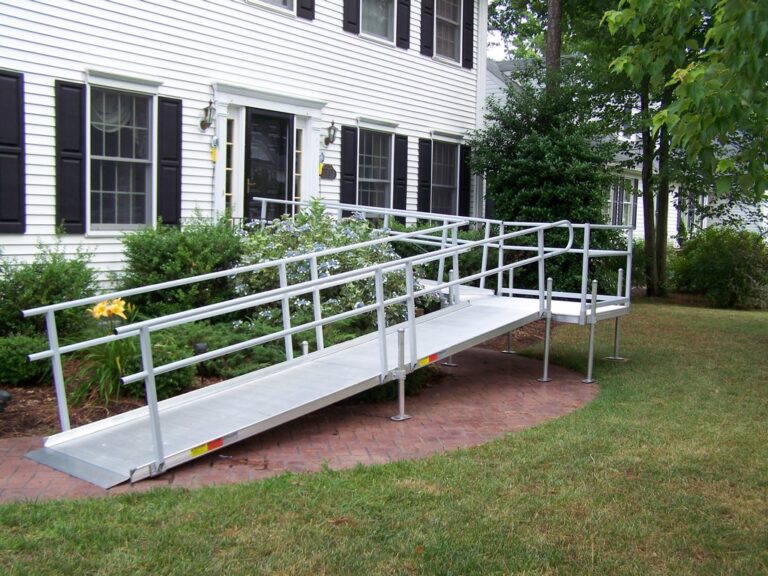

If you are unable to walk up steps, you may need a ramp leading up to your front door. However, most people don’t realize that there are different types of ramps. Learning about these different types of ramps can help you determine which ramp is ideal for your situation.
Deciding which one of these wheelchair ramps is the best option for your home can seem like a daunting task. Features such as, weather conditions safety, ease of access, ADA compliance, expert installation, warranty are just some of things to consider before making a ramp. purchase.
Along with those features, we’ve listed some vitally important points you should take into account in order to choose the proper wheelchair ramp. We want to make sure you have the tools and knowledge to make the best decision for you or your loved ones!
The ADA guidelines provide specific ratios for accessibility ramp measurements that are ensured to optimize safe use. ADA requires that all business and public use ramps adhere to a 1:12 slope ratio, meaning that for every inch of vertical rise there must be 12 horizontal inches (one foot) of the ramp. So in application, if you had a stairway with a vertical rise of 10 inches, you would need 10 feet of ramp. ADA also requires that no ramp can run longer than 30 consecutive feet without a rest or turn platform.
Threshold ramps | 6″ to 24″ |
Suitcase ramps | 24″ to 72″ |
Solid ramps | 24″ to 120″ |
Multi-fold ramps | 60″ to 144″ |
Track ramps | 24″ to 144″ |
Modular ramps | 48″ to unlimited (4 foot increments) |
Deciding on the proper weight capacity for a new wheelchair ramp is important to the user’s safety. Exceeding the maximum weight capacity of these mobility products could lead to ramp failure and accidents.
To decide on the weight capacity needed for a portable wheelchair ramp all things that add weight to the user or their mobility device must be taken into account.
Manual wheelchair users don’t have to worry too much as manual wheelchairs rarely weigh more than 40 lbs and most portable ramps will handle at least 500 lbs so if the user weight is less than 550 lbs there won’t be an issue.
Power wheelchairs and mobility scooters are where wheelchair ramp weight capacities can unexpectedly be exceeded. Power wheelchair manufacturers publish the weight of their products but rarely include the weight of the batteries and never include any accessories or seating that is added to the chair. A power wheelchair that weighs 300 lbs will quite likely weigh 375 to 400 lbs once batteries are added. Seating can add as much as another 50 lbs if complex enough. Add power tilt or recline to a power wheelchair and you’re looking at another 100 lbs to 150 lbs. So the 300 lbs wheelchair you buy can weigh 600 lbs or 700 lbs by the time it’s delivered to you. the only real way to know what the weight of a electric wheelchair or mobility scooter is to have it weighed.
The user is another variable weight factor. While the user themselves may not fluctuate much in weight they rarely take into account their clothing, outerwear or any needed medical devices. Many people also use their mobility device for shopping and their purchases can add a fairly significant amount of weight to their mobility device.
The bottom line is, all things that may be expected to add weight to the mobility device and the person need to be taken into account. Even if added weight is not the norm the pieces of medical equipment that are going to be used must be able to handle the maximum expected weight.
Threshold ramps | up to 850 lbs |
Suitcase ramps | up to 800 lbs |
Solid ramps | up to 850 lbs |
Multi-fold ramps | up to 800 lbs |
Track ramps | up to 2000 lbs |
Modular ramps | Up to 850 lbs |
While these are the maximum capacities I’ve found for the different types, the capacity will vary between manufacturers. When purchasing a wheelchair ramp always check the capacity for the model chosen.
Once we know the weight the ramp must be able to handle and the approximate length that will be required we can look at the style of ramp that will most suitable. One needs to know if portability is actually a requirement and if so how is the ramp going to be moved from place to place.
Threshold ramps are most commonly used for doorway thresholds as the name suggests but they can be used anywhere there is a low rise that needs to be climbed. Portability is not usually an issue as they are normally purchased for a specific location only but they can be moved around if needed.
Suitcase ramps are one of the most common portable wheelchair ramps because they are light in weight and can be easily set up, used, carried and transported. They take up little room when in storage but because their length is usually a maximum of 6′ they are only suitable for fairly low rises. Most suitcase singlefold ramps have a maximum weight capacity or 600 lbs but there are a couple of models with an 800 lbs limit. They are pretty good for manual wheelchairs and smaller power wheelchairs but the bigger power wheelchairs can be too heavy for these ramps.
Multi-fold ramps are available for situations where the suitcase ramp isn’t long enough but there is still a need for portability. The multi-fold ramps are available in lengths up to 12′ long and have weight capacities between 600 lbs and 800 lbs. These ramps are more difficult to set up and use because they usually fold side to side and then fold lengthwise. Additionally the multi-fold ramps tend to be quite heavy to carry and work with compared to singlefold ramps because of their size.
Solid ramps Are the easiest to use because there is no folding or tricky alignment when setting them up. Because they don’t fold their size can make them difficult to carry and transport in a vehicle. The shorter versions of the solid ramps can be used as threshold ramps.
Track ramps are very light depending on their length. They come in lengths up to 12 feet in length and although the Roll-a-ramp models will have weight capacities up to 2,000 lbs but most models will only carry up to 600 lbs maximum. The biggest problem with track ramps is getting them properly set up for use. They need to be parallel to each other and the same distance apart as the wheelbase width of the wheelchair or scooter.
A modular ramp is a long ramp that is typically made from aluminum. It has many pieces that fit together to create a ramp. This type of ramp is ideal there are more than just a few steps leading up to your front door. If there are multiple steps, you may need to build a ramp to the sides of these steps, as going over the steps directly can create a step incline that is unsafe. A modular type of ramp meets these requirements, ensuring you can safely access your home, no matter how many steps lead up to the door.
A Threshold Ramp
In some cases, you don’t have steps that lead up to your door. But the threshold of the door itself creates a step or bump that you are unable to traverse across. In these instances, an aluminum threshold ramp may be ideal. A threshold ramp is typically made of rubber is similar to a mat. It simply lays on top of the bump created by your door way, creating a smooth and flat surface that you can glide across. However, many doors need to be modified when using these ramps, as they may not be able to close with the threshold ramp now in place. A professional can install the ramp and adjust your door accordingly.
If you are in need of a ramp for your home, contact Patriot Mobility today We sell a wide array of home safety products, allowing you to continue to live safely in your home for as long as possible. We can help you determine what type of ramp is ideal for your home and then install it for you.
Contact us for an estimate today. 1 (800) 392-9036
To help with the journey of independence. We have become an industry mobility leader from wheelchair ramps, stairlifts, mobile scooters, vertical platform lifts, scooter lifts and so many more products, we have for.
